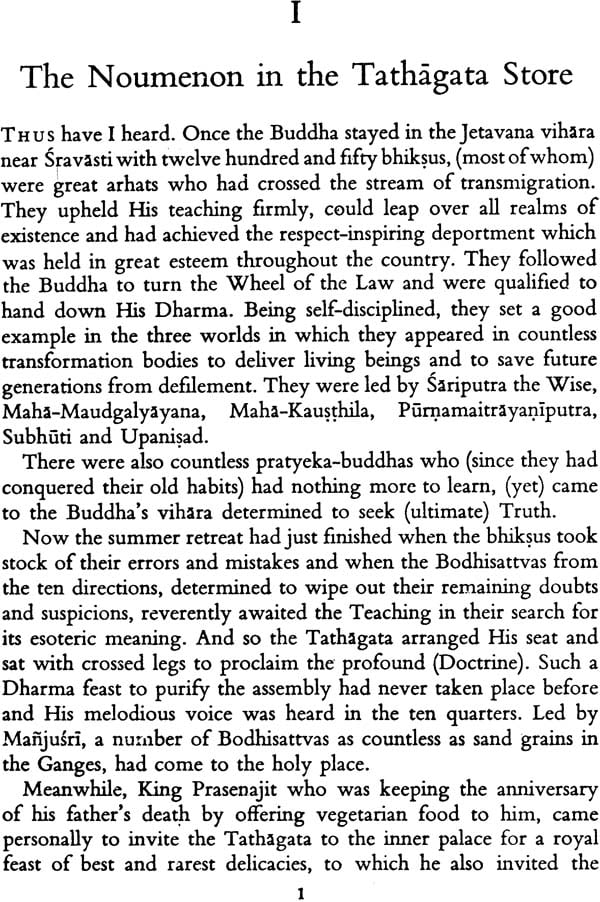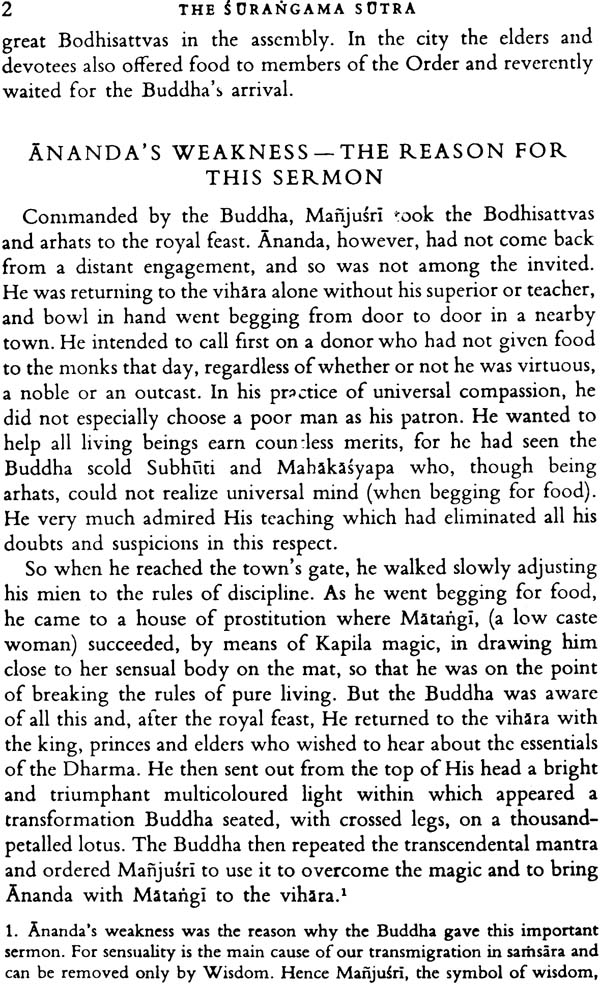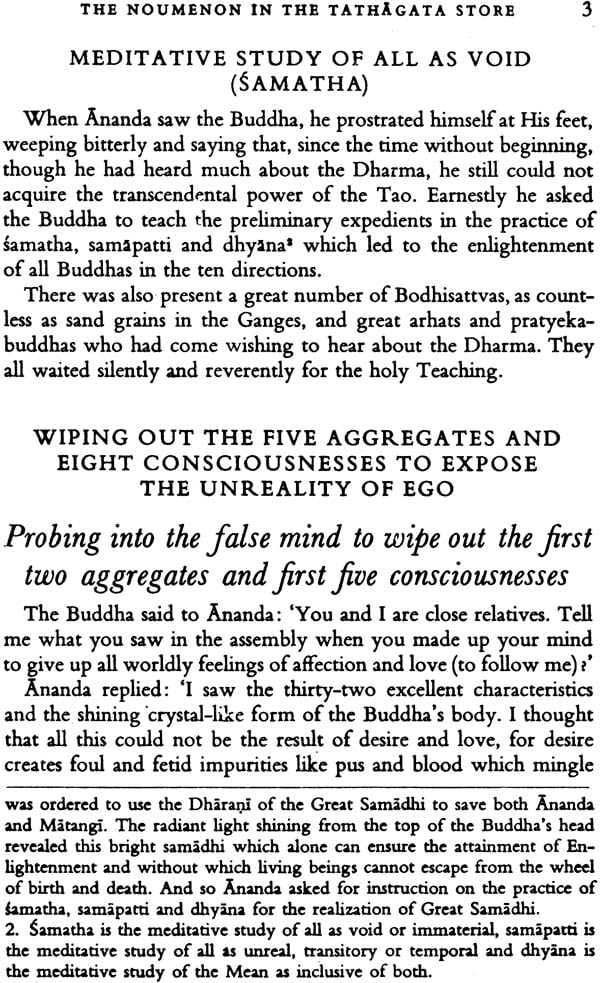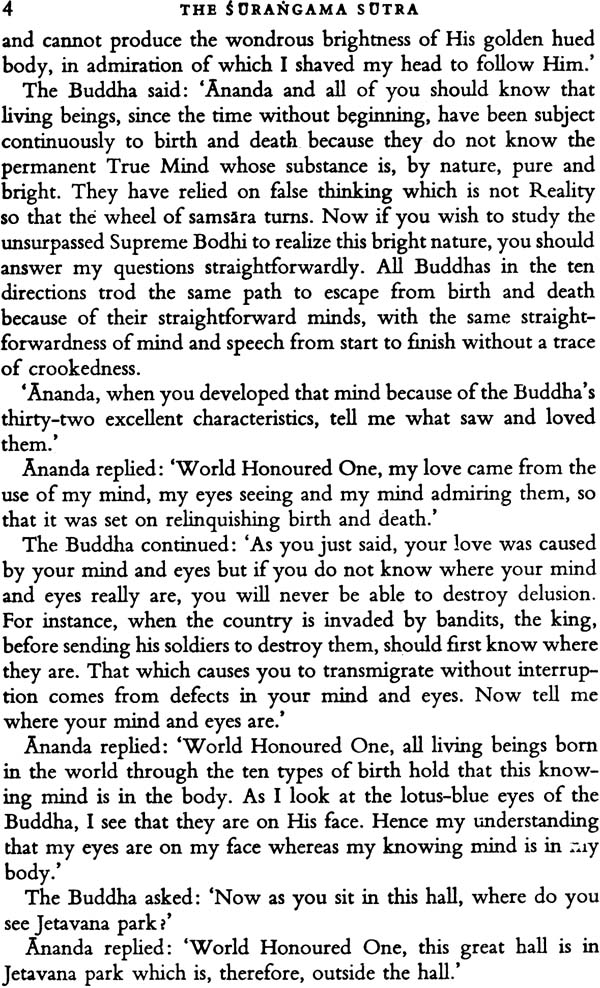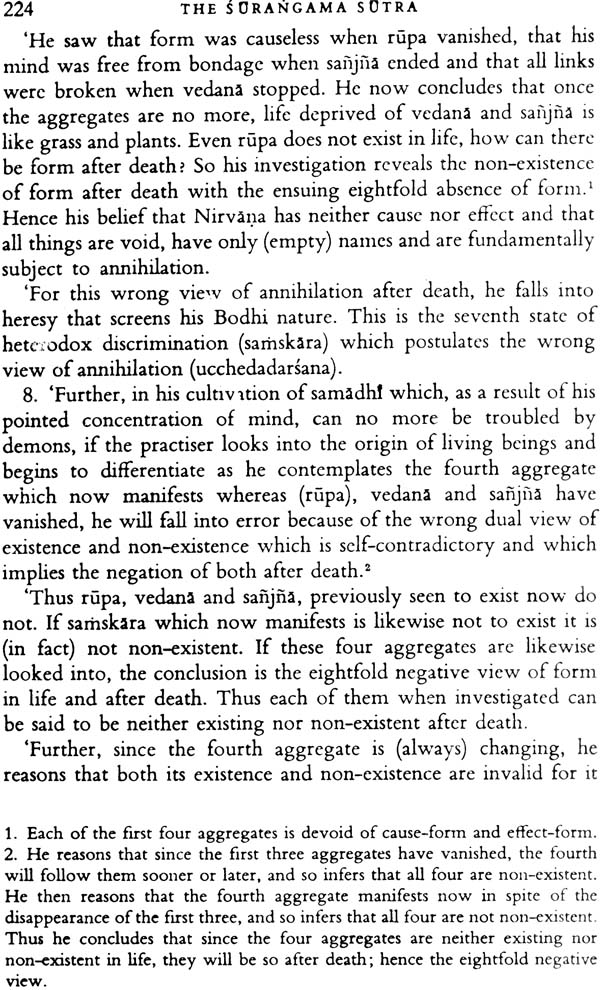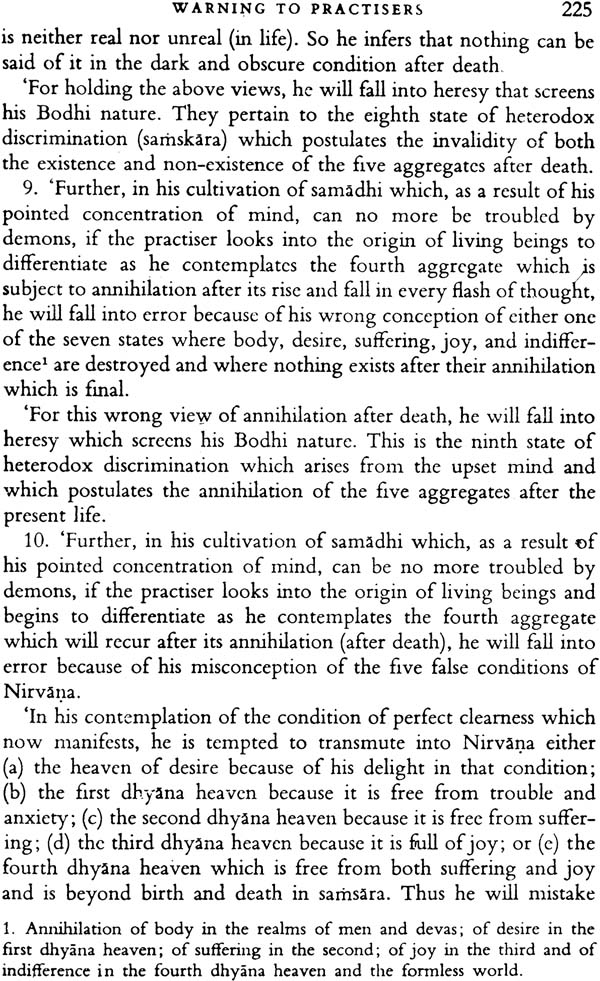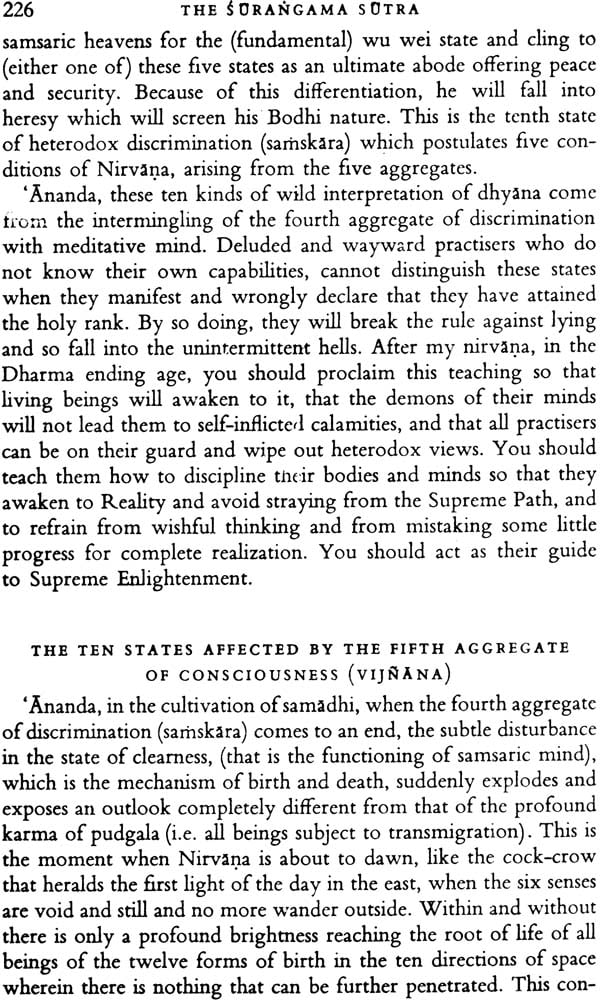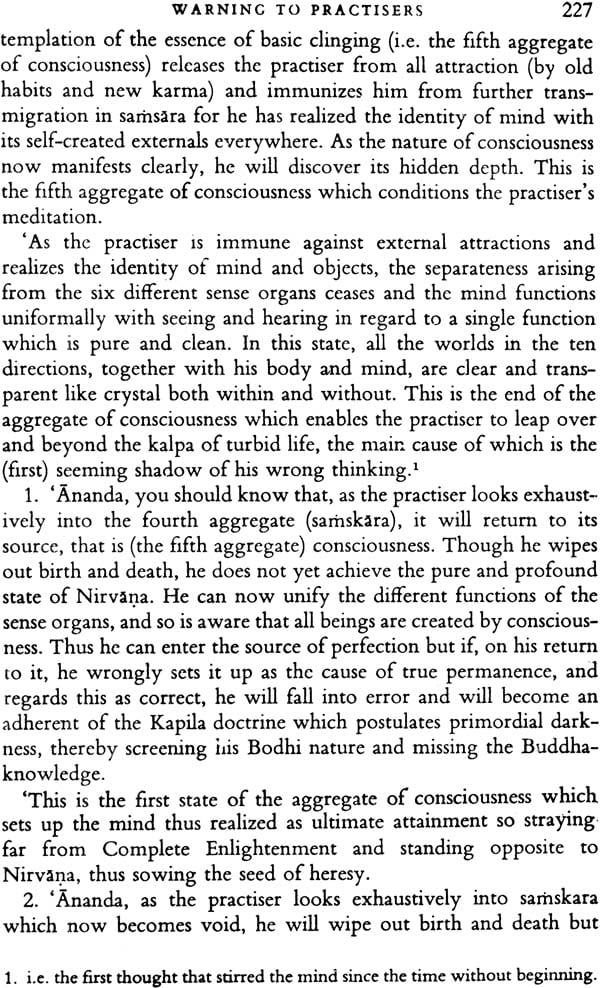
The Surangama Sutra (Leng Yen Ching): Chinese rendering by Master Paramiti of Central North India at Chih Chih Monastery, Canton, China, AD 705/Commentary by Ch'an Master Han Shan (1546-1623).
Book Specification
| Item Code: | IDC911 |
| Author: | Charles Luk |
| Publisher: | MUNSHIRAM MANOHARLAL PUBLISHERS PVT LTD |
| Language: | English |
| Edition: | 2013 |
| ISBN: | 9788121510028 |
| Pages: | 286 |
| Cover: | Hardcover |
| Other Details | 6.0" x 7.6" |
| Weight | 440 gm |
Book Description
From the Jacket:
The Surangama Sutra, or Leng Yen Ching, is a Buddhist apocalyptic text, which, alongwith an abridged commentary by Ch' an Master Han Shan, has ably been translated from Chinese into English by Charles Luk. Containing apocalyptic thinking, it is asserted that this Sutra will disappear upon the disappearance of the dharma. The basic concern of the text is to point out as to how the law of causality terminates in the emergence of delusion, and on account of delusion Samsaric bondage is given rise to. The only way to overcome delusion, and thereby bondage, is to attain the state of enlightenment. Since the attainment of enlightenment is seen as the solution of the problem, the text, thus, engages in laying down the road map of specific practices that enable one to reach the liberative goal of salvation, which is freedom from the law of causality and thereby from delusion and bondage. Insofar as the store consciousness (alaya) continues to function, to that extent causality will remain operative. The methods, as developed in the text, are thus aimed at breaking the alaya. Upon the destruction of three marks of the alaya, which are self-evidencing, perception and form, the practitioner attains what is called the Surangama samadhi, or the gateway to perfect enlightenment. Upon the attainment of enlightenment is revealed the nature of the Tathagata store of one reality.
This important sermon contains the essence of the Buddha's teaching and, as foretold by Him, will be the first sutra to disappear in the Dharma ending age. It reveals the law of causality relating to both delusion and enlightenment and teaches the methods of practice and realization to destroy forever the roots of birth and death. It aims at breaking up alaya, the store consciousness, whose three characteristics are: self-evidencing, perception and form, by means of the three meditative studies of noumenon which is immaterial, of phenomenon which is unreal and of the 'Mean' which is inclusive of both, and leads to the all-embracing Surangama samadhi which is the gateway to Perfect Enlightenment and reveals the nature of the Tathagata store of One Reality.
In the practice of the Surangama samadhi to wipe out the store consciousness, we should know that the latter has been under delusion for a very long time and that it is very difficult to transmute it into the Great Mirror Wisdom. Hence the Buddha uses two of its characteristics, perception and form, to explain the falseness of both so that we can relinquish our attachment to them and break its first characteristic, self-evidencing. The illusion of form which includes the body and mind made of the five aggregates and the visible world is tackled first by returning each of its aspects to where it arises to prove its unreality. Then the illusion of perception is wiped out by revealing its essence, or alaya, which like a second moon is also an illusory creation. Hence the Buddha says: 'When seeing (perceives) seeing, seeing is not seeing (for) seeing strays from seeing; seeing cannot reach it: which Han Shan ably interprets thus: 'When the absolute seeing perceives the essence of seeing, the former is not the latter which still differs from it; how then can false seeing reach that absolute seeing l' Absolute seeing is likened to the real moon in the sky; the essence of seeing to a second moon seen by bad eyes; and false seeing to the moon's reflection in water. In other words, the true moon stands for basic Enlightenment; the second moon for alaya, or the essence of seeing which is close to the true moon; and the moon in water for perception, an illusion which is very far from the real moon. As to alaya which is the unenlightened aspect of the self-nature, we cannot lightly dismiss it as non-existent, and this is why the Buddha avoids mentioning it for, as He says in His gatha:
'Old habits flow like torrents in Alaya's subtle consciousness. Since the real yet unreal can create confusion I have refrained from revealing it to you.'
In answer to Ananda's request for instruction on the three meditative studies (samatha, samapatti and dhyana], the Buddha reveals the light of Surangama samadhi from the host position of the all- embracing One Mind in its state of passionless imperturbability. Readers should not regard this revelation as some kind of miracle which cannot be proved by science and which should be dismissed as nonsense. We have mentioned in our previous book, The Secrets of Chinese Meditation that all serious students of the Dharma experience this state of brightness as soon as they succeed in stilling their minds in the practice of dhyana.
This absolute Mind as revealed by the Buddha, has three great characteristics: greatness of its essence or substance, called Dharmakaya; greatness of its attributes or manifestations, perfect in wisdom and mercy, called Sambhogakaya; and the greatness of its functions, perfectly converting all living beings to the right Path, called Nirmanakaya.
Instead of cognizing the True Mind, we cling to the illusory body and mind made of the five aggregates as an ego, with sense data in the surrounding world as its objective field of activity. This coarse attachment to ego and things (dharma) arises from discrimination and pertains to both the sixth and seventh consciousnesses. The subtle attachment to ego and Dharma is inborn for it arises from the seventh consciousness clinging to alaya's perception as an inner ego and its realization of sainthood as Dharma. Only after wiping out both discriminative and inborn attachments can we reach the source of the One Mind and attain Enlightenment. Hence the three meditative studies which aim at destroying both coarse and subtle clingings.
It is much easier to relinquish she discriminative clinging than the inborn attachment and few practisers succeed in overcoming the latter; hence Han Shan says: 'This pass is the most difficult one to get through and only one or two percent of practisers can succeed in negotiating it.' (See The Secrets of Chinese Meditation, p. 58, Rider and Co.) Here is the great difference between the Buddha Dharma and the teachings of other religions in the Orient.
The inborn attachment to an ego can be cut off only after one has reached the seventh stage of Bodhisattva development whereas the inborn clinging to Dharma still remains in and above the eighth stage, for the seventh consciousness has its unclean and clean characteristics. The unclean one is wiped out in the seventh stage when the name of store consciousness is dropped and replaced by that of pure consciousness which can now be transmuted into the Absolute. However the seventh consciousness still remains and clings to the Absolute as the object aimed at; this is the subtle attachment to Dharma. Hence the Buddha says: 'The idea that Bodhi Mind is created after the samsaric mind has been annihilated pertains to samsara' (see p. 99), for this clinging to the Absolute that can be attained also implies the duality of subject and object, that is attachment to Dharma. Only after this last attachment has been cut off can Enlightenment be realized. These two coarse and subtle attachments do not go beyond the Eighth Consciousness and its created five aggregates, the breaking up of which is the aim of the teaching in this sutra.
This sermon deals with basic Ignorance caused by the first dim thought of self-awareness as subject and its counterpart, dull emptiness, as object. The dimness so created by mind's separateness is called Primordial Darkness by non-Buddhist philosophers in the East and is the origin of creation according to the Buddha's teaching which then explains the three subtle causes of unenlightenment: basic ignorance, subject and object, and its six coarse conditions: knowledge, responsiveness, attachment, assigning names to objects, karmic activity and suffering. These six conditions result in the manifestation of different forms, such as the world and living beings in the store consciousness. Here begins the law of continuity: that of the physical world resting on the four wheels of wind, water, metal and space which spring from the illusion thus created; that of living beings of the four types of birth; and that of karmic retribution caused by carnality, killing and stealing, the three cardinal conditions of birth and death.
The Buddha orders the twenty-five enlightened ones in the assembly to disclose the various means by which they have attained enlightenment so that others can learn something from them. After their statements of their realization by means of the six sense data, six sense organs, six consciousnesses and seven elements of fire, earth, water, wind, space, consciousness and perception, the World Honoured One asks Manjusri for his opinion on these twenty-five methods. Mafijusri praises Avalokitesvara Bodhisattva for the latter's method by means of the organ of hearing which is the most suitable for human beings.
The Buddha then teaches the assembly the Surangama mantra and rituals for avoiding all obstructions on the Path to Enlightenment. We have not presented this section of the sutra partly because the Chinese transliteration of the mantra is corrupt so that an English transliteration would be misleading, and partly because of lack of space. Moreover, the average Western student of Buddhism seems to have little faith in mantras and rituals which should not be published lest they create unnecessary disbelief and confusion and so compromise the beauty of this profound sutra.
The Buddha goes on to explain why living beings are caught in the net of samsara through the twelve types of birth and how to escape by practising the fifty five gradual stages of Bodhisattva development to realize Complete Enlightenment. As asked by Ananda, He described the realms of hells, the ten realms each of hungry ghosts, animals, human beings and seers; the six deva realms of desire, the eighteen deva realms of form, the four deva realms beyond form and the four realms of titans.
Before the meeting ends, the Buddha warns the assembly against fifty mental states caused by the five aggregates which hinder the practice of Dharma. These states should be recognized by all students in their meditation and cases are known of those having visions of Buddhas and Bodhisattvas who by clinging to them, fell into heresy and thereby returned to samsara.
This translation is based on the explanation and commentary written by Master Han Shan of the Ming dynasty after his own enlightenment. The original Chinese text is a forest of vertical columns and is not divided, as in our presentation, into chapters with headings and sub-headings which the master added for the benefit of students. After this important sutra reached China it was read and studied by all great masters before and after their major awakening, and was widely expounded and commented on in all well-known monasteries throughout the country. According to the late master Hsu Yun, it should be studied carefully until it is well understood by students of Mahayana and Chan before they begin their spiritual training.
In spite of our desire long ago to present this sutra to sincere students in the West, we hesitated to do so because it is very profound and is beyond the comprehension of materialistic commentators and blasphemers who are inclined to seize every opportunity to criticize and vilify the holy Teaching thereby misleading the reading public and causing embarrassment and even loss of money to well-meaning publishers. A European book reviewer recently took the unnecessary trouble to question our competence to translate sutras in sanskrit without appreciating that we have only Chinese sutras in our country so that all our translations are from Chinese texts.
We are, however, indebted to our two Canadian readers, Mr. and Mrs. Carroll Aikins, who have studied and practised Mahayana and Chan for some thirty-five years and who, when hearing of our hesitation during their visit -to Hongkong in 1963, immediately offered to purchase a thousand copies of our translation for free distribution. They told us that it was worth spending money to spread the Buddha Dharma, and we can find no words to express our thanks and gratitude for their encouragement and valuable support in this Dharma ending age.
All brackets are mine and are added to make the sutra and commentary more clear and intelligible to sincere students of the Dharma in the West. Only part of Han Shan's commentary has been translated and is presented in the form of footnotes.
